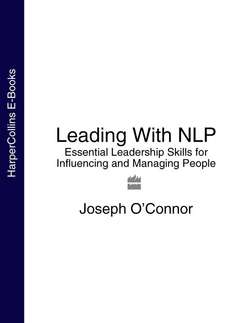Читать книгу Leading With NLP: Essential Leadership Skills for Influencing and Managing People - Joseph O’Connor - Страница 12
Leaders in Perspective
ОглавлениеMental perspective influences how leaders are perceived too. Some leaders seem more accessible than others and this may have to do with how closely we imagine them in our mind’s eye. Take the saying: ‘A general commands, a good leader leads and a great leader finds out where everyone’s going and gets out in front.’ A leader goes out in front, perhaps literally, certainly metaphorically. How far out in front should they be? Think about emotional distance. We talk about people being ‘distant’ and of ‘staying in touch’ and of ‘hands on’ management and ‘close’ friends and family. When a leader ventures too far ahead, the smaller they appear, and they get ‘out of touch’ and no longer understand the mood and feelings of those they are supposed to be leading. A distant leader can make the goal seem distant too.
Hierarchies create distance in another dimension, as we talk about a leader being ‘above’ their followers. In my view, vertical distance represents authority and horizontal distance emotional closeness or loyalty. A leader who has authority in a hierarchy can still be ‘close’ to their followers and many military leaders create fantastic loyalty in their troops because even the lowest ranks feel their commander understands them. It also helps if a leader has ‘risen through the ranks’. Then they really are more likely to understand the concerns of the people they lead and it also gives them a credibility with their followers that an outside leader lacks. The more authority you have, the further up the hierarchy you are, and organizations with many levels of management risk creating too great a distance between the leaders and the followers.
We are not usually aware of how we think about leaders, but our view can affect how comfortable we feel about being a leader ourselves. If you think of a leader as large and looming over you, for example, you may feel uncomfortable about being a leader to others, because that would mean looming over them. When leaders are put on a pedestal, not only are their feet of clay more visible, but it’s further to fall!
Consider what being a leader means to you. You will not want to go on the leadership journey if you believe that a leader has to be manipulative or superior.
Your ideas about leaders will be influenced by your experience of them. In 1997 I gave the first public NLP and business seminar in Prague in the Czech Republic, and the subject of leadership came up. I do not speak Czech so I had a translator and it soon became clear that the language did not have a word that adequately translated the concept that I was using the English word ‘leader’ to describe. They had two words: manazer, meaning ‘an administrator’, and vudce, meaning ‘a Communist Party leader’. The seminar participants said a Communist Party ‘leader’ had no authority of their own (it came from Moscow), no vision (they did as they were told), little knowledge and was certainly no role model as they would consistently go home first at the end of the day’s work! Such was the Czech cultural experience of their erstwhile Russian ‘leaders’ that we had to coin a new word to even begin to discuss the concept. In the end we decided to use the English word ‘leader’. So a new word and a new concept entered the Czech language that day.
Our culture influences how we think of leaders. Some cultures, France for example, put more distance between leaders and followers. The social hierarchies are more pervasive. The greater the distance between leader and follower, the more difficult it seems to be a leader. You have further to ‘climb’ and more risks to take, because ‘the nail that stands up gets hammered down’. In egalitarian cultures, such as America, the social landscape is flatter and leadership appears to be within the reach of everyone. It’s possible for anyone to become US President (at least in theory, although a lot of cash helps).
Explore your own ideas about leadership with the following exercises.
